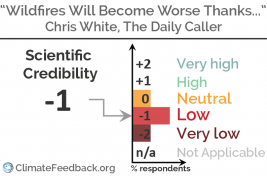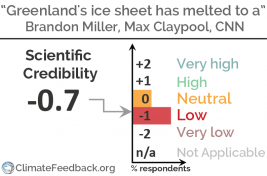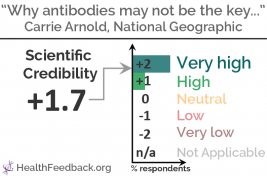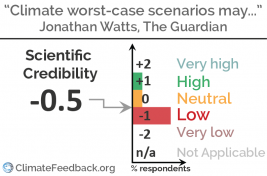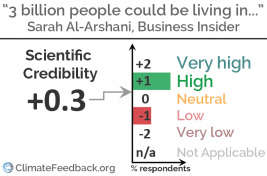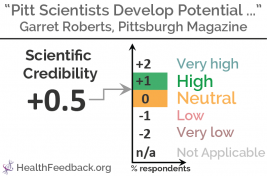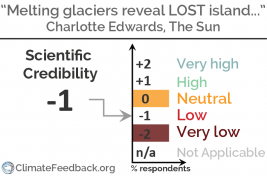Article Reviews
“Is this article consistent with the latest thinking and knowledge in science?”
“Would experts in this field endorse the main message of this article?”
These are the types of questions our “feedbacks” are designed to answer. If the feedback is positive, you can generally assume the information you’re reading is of high credibility. If it’s negative, however, you may want to read with extra care and attention — some of the information contained and conclusions reached are not consistent with science.[1]
New York Post article makes speculative, unsupported claim that mutation could enable the virus causing COVID-19 to evade handwashing and mask-wearing
in New York Post, by Jackie Salo
"The preprint that the article focuses on actually says nothing about the most egregious claim made in the article: that the virus is evolving to get around hand-washing, masks, etc. This comes from a quote from someone who’s not an author on the preprint, giving an opinion about the preprint…on a topic not covered by the preprint."
— 08 Oct 2020
Article by The Daily Caller oversimplifies drivers of wildfires and downplays role of climate change
in The Daily Caller, by Chris White
"The causes of the increase in burned area in the western US in recent decades – and the record-setting fires of 2020 – are complex, driven by a mix of a changing climate, a 100-year legacy of overzealous fire suppression in forests adapted for frequent low-level fires, more people living in highly flammable wildland urban interface areas, and at times a counterproductive role of some environmental regulations. However, this article glosses over much of this complexity, presenting a simple but misleading narrative that land management rules enacted by the Clinton administration set the stage for the destructive fires we are experiencing today."
— 28 Sep 2020
Article by CNN exaggerates study’s implications for future Greenland ice loss with “point of no return” claim
in CNN, by Max Claypool and Brandon Miller
The article in CNN discusses findings from a study published August, 2020 that analyzes trends of ice discharge from the Greenland Ice Sheet over the past three decades[1]. Reports on this study were also published by Reuters and Phys.org, receiving over 200,000 interactions on Facebook across the three articles, according to CrowdTangle. Scientists who reviewed … Continued
— 20 Aug 2020
Potential role for T cells in COVID-19 immunity accurately reported in National Geographic article
in National Geographic, by Carrie Arnold
"The article accurately discusses the recent findings about the presence/relevance of T cell response against COVID-19. Indeed, both arms of adaptive immunity, humoral and cellular, contribute in different ways to the body’s fight against viral infections. What remains to be seen and explored in greater detail is how important the role of antigen-specific T cells is in protecting people from a re-infection or ameliorating the disease symptoms."
— 19 Aug 2020
Article by Michael Shellenberger mixes accurate and inaccurate claims in support of a misleading and overly simplistic argumentation about climate change
in Forbes, by Michael Shellenberger
"Shellenberger’s article promoting his new book “Apocalypse Never” includes a mix of accurate, misleading, and patently false statements. While it is useful to push back against claims that climate change will lead to the end of the world or human extinction, to do so by inaccurately downplaying real climate risks is deeply problematic and counterproductive."
— 06 Jul 2020
Article in The Guardian misleads readers about sensitivity of climate models by narrowly focusing on single study
in The Guardian, by Jonathan Watts
"The article correctly reports that the most recent versions of some climate models estimate more warming for a given increase in CO2 concentrations. It is also correct in highlighting that how clouds are represented in these models is the likely reason for these higher estimates. However, it does not report all the science available on this topic and its claims are thus misleading."
— 18 Jun 2020
People who do not show symptoms can contribute to significant COVID-19 transmission, contrary to CNBC report
in CNBC, by William Feuer, Noah Higgins-Dunn
there is already “abundant data” showing that people who are not showing symptoms—which could include asymptomatic, presymptomatic, and paucisymptomatic individuals—comprise about 40 to 50% of COVID-19 cases
— 10 Jun 2020
Article in Business Insider accurately describes results from a study estimating up to 3 billion people could live in much warmer temperatures by 2070
in Business Insider, by Sarah Al-Arshani
The article in Business Insider discusses findings from a study published May, 2020 that projected one to three billion people could live in much warmer climates by 2070, assuming migration is limited and greenhouse gas emissions remain high. The Business Insider article accurately describes the study’s projected changes in mean annual temperatures around the globe, however, the study does not describe these increased temperatures as “unbearable” or “unlivable,” as claimed in the article.
— 12 May 2020
COVID-19 vaccine candidate by Pittsburgh scientists show promising results in animal studies, but clinical trials still needed before efficacy in humans is known
in Pittsburgh Magazine, by Garret Roberts
Scientists who reviewed this article’s scientific credibility found that the reporting was generally accurate. However, they also highlighted a missed opportunity to provide readers with more information to place the research findings in context. Ian Frazer, immunologist and professor at the University of Queensland, pointed out that the article “assumes that an immune response in mice would equate to protection of humans against viral infection, but there are many examples where that is not the case”.
— 11 Apr 2020
Article in The Sun misrepresents Antarctic discovery and misplaces it on map
in The Sun, by Charlotte Edwards
This article in The Sun describes the chance discovery of a small island in Antarctica’s Pine Island Bay, which seems to have appeared in the last decade. But the article sensationally connects this with a recent record high temperature at a station elsewhere in Antarctica. While warming trends in the atmosphere and ocean may be relevant, a single weather record is not. It is not yet clear what is responsible for the island’s appearance.
— 10 Mar 2020
[1] Note: These feedbacks do not constitute endorsements of the author’s political or economic ideology, rather they are assessments of the scientific foundations and reasoning of the argumentation contained within each article.


